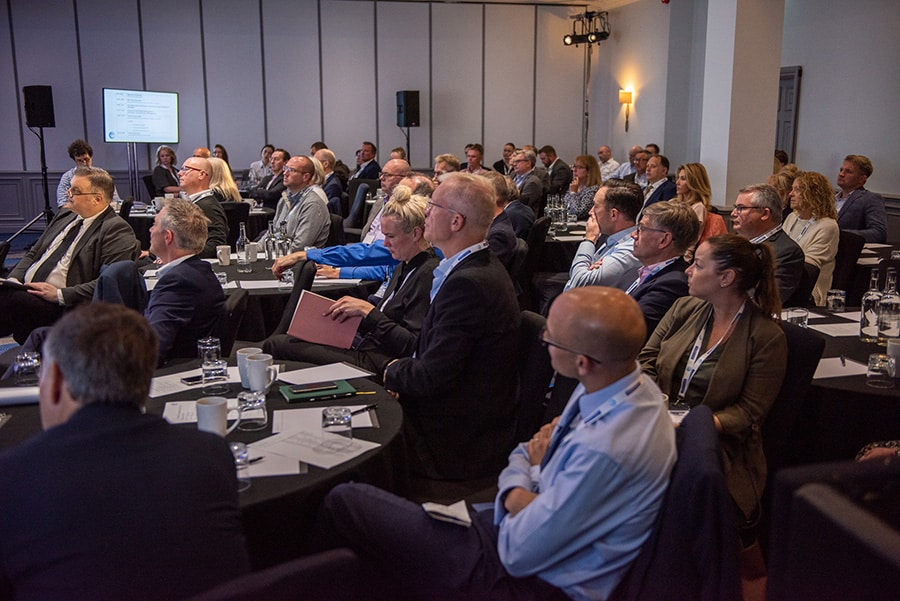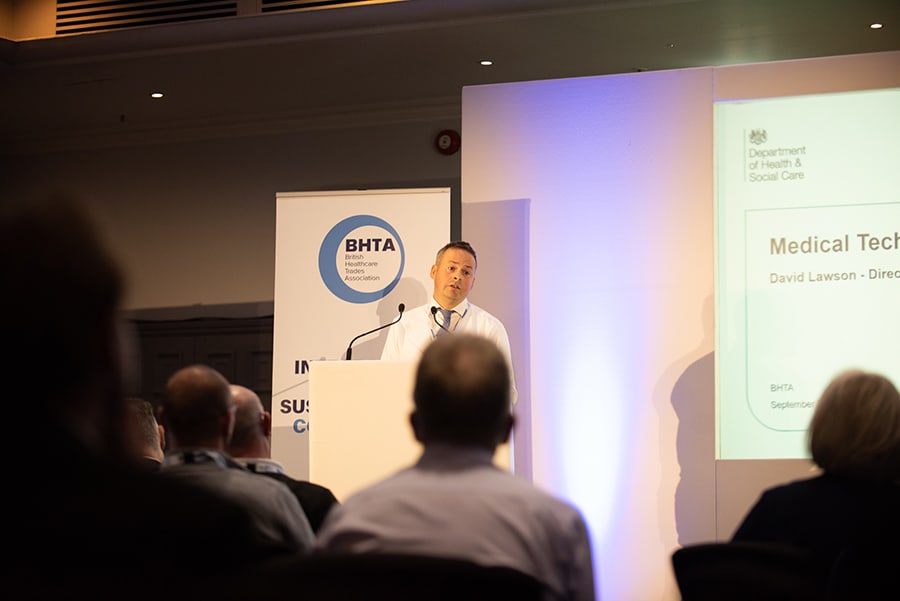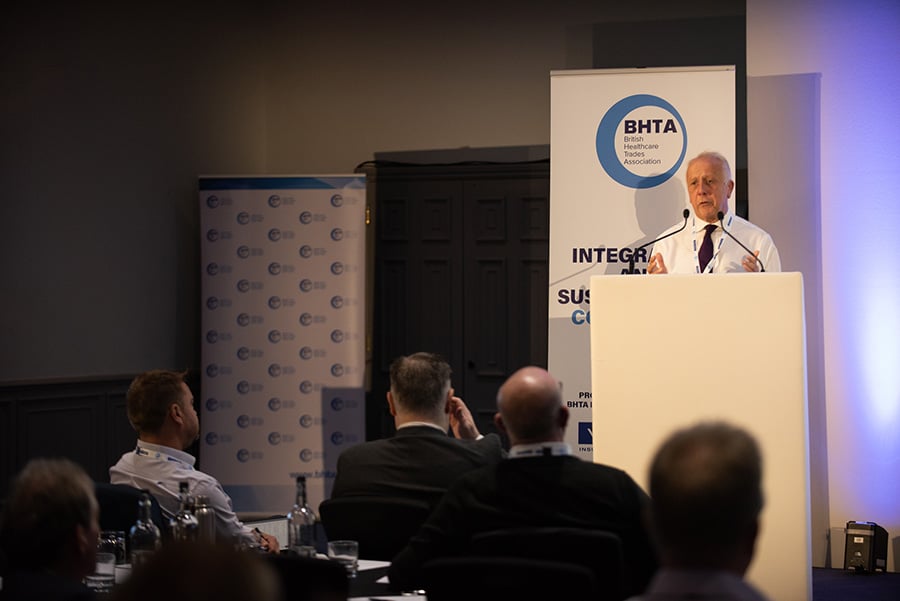Invaluable conference discusses upcoming medtech strategy, DHSC’s innovation framework, and value-based procurement

September 2022 saw a range of senior NHS and government figures discuss two of the most pressing topics affecting healthcare today – integration and sustainability – at an invaluable conference for healthcare and assistive technology professionals and suppliers.
Hearing from those responsible for setting healthcare policy, BHTA Integration and Sustainability Conference 2022 guests gained expert insights into the changing and complex landscape of integration and sustainability.
What will be included in the Department of Health and Social Care’s upcoming UK medtech strategy, building supply chain and workforce resilience, and improving data visibility within the NHS are just some of the topics that were explored at the inaugural British Healthcare Trades Association (BHTA) Conference.
The event took place on 22 September at The Tower Hotel in London, set to the scenic backdrop of London’s iconic Tower Bridge.
Both BHTA member companies and non-member organisations were invited to hear thought-provoking presentations on embedding integration and sustainability initiatives, as well as professionals who wanted to learn more about the future of these two areas.
From understanding some of the major changes to the healthcare landscape to discussions around value-based procurement, attendees left the conference with a tonne of helpful information and guidance.
The afternoon sessions were delivered by David Lawson MCIPS, Director of Medical Technology – Department for Health and Social Care (DHSC); Kevin Hodges, Membership Engagement Manager at the British Healthcare Trades Association; and Francis Philippa, Strategy Lead at Foundations UK.
Previously, AT Today covered the fantastic morning session conference content, which featured important topics like working towards an NHS net zero by 2045, what the new NHS Central Commercial Function (CCF) is, and how procurement is changing to be more value focused.
Below, AT Today delves into the fascinating conference content from the afternoon presentations as well as the stimulating panel discussion.
What the upcoming DHSC medtech strategy will contain

David Lawson MCIPS, Director of Medical Technology – Department for Health and Social Care (DHSC), shared an important presentation about what the upcoming medtech strategy will contain.
The strategy will detail plans for how DHSC will shape the £10 billion+ medical technology (medtech) sector in the UK, and how industry and government can work collaboratively to collectively shape the medtech market for the NHS.
David outlined some priority areas and objectives for the upcoming medtech strategy: embedding sustainability, resilience, value for money, innovation, and the regulatory framework.
Explaining the strategy’s structure, David said: “The vision is around right price, right product, right place. I believe each of those themes can sometimes compete with each other. The purpose of the strategy is to try to get a fair balance between those different elements.”
One of the key points from David’s talk was the necessity of building up supply chain resilience – something that will feature heavily in the strategy. There are four key areas to building up supply chain resilience to avoid system shortages and prevent major backlogs.
The first area is around strengthening the medtech supply chain.
“There are supply chains that are more vulnerable to shocks,” David stated. “What we want to do moving forward is to work out with industry and the NHS how we rebalance that and what are the best ways to put resilience back into our supply chains. I see it as a joint responsibility between the industry and NHS.”
He believes that industry can put more stock into the system to avoid shortages, while the NHS can do a better job at managing inventory to make this work.
Secondly, David cited the trend of the medtech sector offshoring. He said that more work needs to be done to support medtech manufacturing in the UK to make it less vulnerable. David wants to encourage more UK manufacturing.
Thirdly, stepping away from single-use products and moving towards more reusable medtech and assistive technology products will be crucial for supply chain resilience.
Added David: “The more that products are single-use, the more vulnerable our supply chains are because we’re dependent on a constant flow of these single-use consumables. I saw this during the pandemic trying to get PPE from four corners of the globe. There needs to be a push to encourage and support a rebalance to try to adopt more reusable products where appropriate, but also in terms of remanufacturing.
“We’re working with NHS England and NHS Supply Chain to push and support a move to reusable. It has a direct benefit, we think, in terms of resilience.”
The final area to build supply chain resilience is to identify products, which is predicted to be around 10-15 products according to David, that disproportionately have a negative impact on the supply chain when they are not available. This could be down to a lack of interoperability or because the product is the only one in the supply chain.
Another key area for the medtech strategy, which is also a theme that featured consistently throughout the BHTA Integration and Sustainability Conference 2022, is innovation.
David remarked: “My suspicion is that you’re not quite sure what the NHS wants. I don’t think we are systematic enough in terms of demand-signalling. We may do it in small pockets, but the NHS needs to be better at signposting what we want in terms of innovation and development.
“Equally, within the NHS, I’m not sure they know which products to buy because we aren’t very good in providing that systematic fact base to say which are the most effective products in different categories. Again, there are pockets where that’s in place, but at a general level, people are not sure what to buy. We’re both in this kind of confused state.”
Interestingly, David discussed the idea that there are two types of innovation: game-changing inventions and incremental improvements that are innovative. In David’s view, incremental innovation is just as important as game-changing innovation.
With this in mind, the strategy’s intention is to create a framework that defines different types of innovation. This framework also better map what the pathway is for innovation.
Continued David: “There’s going to be a move to greater assessment of products, using NICE where they’re doing product-level assessment to do class-based assessments to try to get that assessment and understanding.
“There’s something about trying to get a single voice from the clinical side around different [product] categories to collect insight into what products are most effective in different circumstances.”
Another big area of DHSC’s upcoming medtech strategy is to improve data and visibility. This will allow for more informed decisions and better planning with the NHS and DHSC.
Changing healthcare landscape

Reflecting on the various presentations throughout the BHTA conference and highlighting some of the key changes facing the healthcare landscape currently, Kevin Hodges, Membership Engagement Manager at the BHTA, shared an insightful presentation on different industry perspectives.
He noted how much has changed from a policy perspective with recent regulatory changes regarding integrated care systems (ICSs), integrated care boards (ICBs), and integrated care partnerships (ICPs).
“ICBs, in terms of their remit, is to allocate budgets, commission services, and develop a five-year plan.” explained Kevin. “This is a distinct remit that they have versus the ICP, which should lead the integrated care strategy and plan for wider healthcare needs. That’s the split of responsibilities. The ICB is very much the governing part of the ICS.”
Kevin agreed with other points made throughout the BHTA Integration and Sustainability Conference 2022 about centralism vs localism in terms of policy setting and policy implementation.
“If it makes sense to buy things centrally, we should do it. However, I think there is a recognition that because of the different demographics and the different population needs in different areas of the country, there needs to be an element localisation.”
Kevin noted that Preeya Bailie, Director of Procurement Transformation and Commercial Delivery for NHS England & Improvement, did a great job of scene-setting how the NHS Central Commercial Function (CCF) will work in her morning presentation. He mentioned that the BHTA and members are waiting for further details on who will be responsible for the different elements of the CCF.
Kevin further outlined changes to medical device marking regulations in the UK following Brexit, and the challenges and confusion this has created for manufacturers.
“You’ve got the three-to-five-year transition period, but there’s still so much issue with a shortage of both authorised bodies and notified bodies, and the whole way it’s going to be aligned or not aligned to European MDR. Currently it’s sort of aligned but maybe not perfectly. We have that one still to deal with, but maybe but there is a little that we know with certain companies having some real challenges.”
The BHTA is there to help members navigate through all of these healthcare landscape changes and any concerns they may be facing.
Kevin concluded: “We are working on your behalf with stakeholders already. There are a number of discussions going on about price increases in certain areas. There are some new initiatives that we’re looking at on behalf of you to fully demonstrate the severe cost pressures that you’re under across the board.”
Integrating housing, healthcare, and social care

Francis Philippa, Strategy Lead for Foundations UK, explained how Foundations UK is contracted by the Department of Levelling Up, Housing and Communities (DLUHC) to oversee a national network of nearly 200 home improvement agencies and handyperson providers across the country.
Francis discussed the importance of integrating house with health and social care – a step that has often been overlooked throughout the years.
“The places people live become increasingly important, as we take care of people out of hospital and in the communities,” he highlighted. “80 percent of people, that’s also 80 percent of patients, live in houses that they own themselves.
“Most of the houses that we’re going to be living in in 30 years’ time have already been built. We’re going to have to deal with both the existing stock and the existing structure of the housing market. That’s why integrating housing is so important.”
Francis added that as DHSC and NHS England are focusing on making place-based plans – or localism – this is a positive step for housing, as it enables housing to better integrate with health and social care with the recognition that places are different from one another.
Defining “value” from a policy, procurement, and industry perspective

The conference afternoon panel consisted of David Lawson MCIPS, Director of Medical Technology – Department for Health and Social Care (DHSC); Francis Philippa, Strategy Lead at Foundations UK; and Bob Russel, who sits on the BHTA Board of Directors. It was chaired by David Stockdale, BHTA CEO.
The panel discussion again prompted some very interesting conversations. David Stockdale asked the panel what “value” means from a policy, procurement, and industry perspective.
Bob noted that the term “value-based procurement” has been around for quite a while but has not ever fully become mainstream. He provided an example of a specific contract about three years ago that was all about value. However, once COVID hit, the contract reverted to being just about cost.
“How do we make value-based procurement live in subsequent years?” Bob asked.
David Lawson brought up the interesting point that “value” needs to have a common understanding among both procurement teams and suppliers.
He added: “Procurement teams have had to get their heads round why it’s better to buy something that’s more expensive. It’s quite hard sometimes for people to change what they’ve been used to doing. Equally, from an industry perspective, it’s about being able to articulate the value but also understand how to communicate that at the relevant levels.”
Francis feels as though procurement still frequently centres on price.
“What procurement does, sometimes, is to chase it down to the lowest common denominator.
“People have aspirations about what they have in their homes. It’s a very different sell to the tension between what the manufacturers legitimately want to make for people’s home, and what the state will legitimately want to pay for in people’s homes. It’s really difficult to manage.
“I think discussions about value are not fully formed because they centre on price.”
Building industry and NHS workforce resilience
A valid question came from an audience member who asked the afternoon panel what work is being done around staff resilience. She mentioned that there had been a lot of discussions around supply chain resilience throughout the conference, but that workforce vacancies continue to pose major challenges to both industry and the NHS.
David Lawson responded that while the MedTech Directorate centres around medtech, and that there are other parts of DHSC that focus on workforce resilience, he wonders if there is anything the directorate can do to support this issue.
“Are there things that through medtech and innovation that we can do to mitigate the problem?” He wondered. “Is it about moving towards changes to practice to more effectively utilise the resources that are there to avoid resource being wasted because there are tasks and activities that could be designed out if we adopt a change in practice. Maybe that’s where the link for medtech is. It’s around looking at innovation in order to help address the workforce challenges.”
Francis echoed David’s points and believes innovation is the only way forward to address the major workforce shortages facing the healthcare sector currently.
“If we’re going to attract new people, we’re going to have to attract new technology and new ways of working as well,” he underlined.
Bob felt there is no straightforward answer to solving workforce resilience but agreed that encouraging different and more flexible ways of working is necessary. He cited offering staff the ability to work from home, where possible, could be one way of helping address some of the difficulties.

